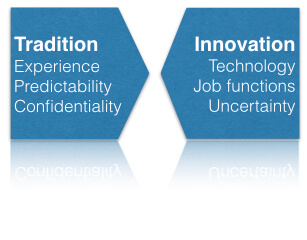By:
The advantage of cultural diversity
The world has changed dramatically over the past 20 years due to globalisation, global de-regulation, new technologies and significant changes in the global political and economic environment. And it has become more culturally diversi so a national question is: How can we take advantage of the cultural diversity. The importance of being able to take advantage of cultural diversity has increased dramatically. Most mergers and acquisitions fail due to cultural clashes. Regional and global conflicts are fuelled by cultural stereotyping.
Usually, dramatic changes in the external environment lead to changes everywhere, but it doesn’t seem to have been the case with how we organise, motivate and reward people in global operating companies.
The article is about the challenges global operating companies are facing and what we must do in order to develop organisations and systems that match the current and future external environment. These are all thoughts that were developed over the past 10 years while working with companies around the world dealing with cultural diversity and fine-tuned during the preparation of my doctoral dissertation.
Gugin has helped hundreds of companies around the world taking advantage of cultural diversity and even before I started Gugin in 2001 I knew that most of the challenges I was facing as manager in global operating companies in one way or the other were related to differences in cultures. Differences in cultures and the underlying personal value system often created so much operational friction that it sometimes became impossible to fulfil the goals and objectives.
Then one can ask. If differences in culture are such a huge obstacle for achieving success in global operating companies why don’t we put a lot of resources into finding a solution? Most people don’t see the advantage of cultural diversity. Most people see it as something that has to be fixed. So the main barrier
After having talked to a lot of clients and attendees on my courses about it I had to conclude that most people fall in one of two categories.
They either don’t believe in things that do not appear in a spreadsheet or they don’t have the internal organisational power in their company to change the focus to cross-cultural team effectiveness.
So before starting the project of writing a doctoral dissertation on the subject I was keen to find out whether or not the challenges of managing and leading global organisation were real or only existed in the heads of people working in the HR departments.
I, therefore, decided to conduct a survey of middle managers in global operating companies around the world. I decided to define a global company as a company who has its presence on at least 3 continents. I also decided only to ask middle managers because they feel the daily dilemma between the different cultures and the dilemma between the corporate culture and the various national and professional cultures.
The Research Process
From my 18900 contacts on LinkedIn, I selected 6560 people who met the criteria. I also submitted the survey to the professional groups I administer on LinkedIn and Xing. Former colleagues and clients in IBM, CSC, Fortis, Microsoft, BNP, Novartis, Apple and Shell were very helpful in distributing the survey among their colleagues.
Consequently, I don’t know exactly how many people have received an invitation to take the survey, but 1292 people have answered it, and I am going to dwell with a few of the results in this article.
I was interested in getting to know whether the cultural diversity was seen as an obstacle or an opportunity. The response surprised me a great deal. 93% of the respondents think it is essential or important that their company take advantage of the cultural diversity. This can, of course, be done in many different ways, but it is definitely a showdown with the old attitude that we have seen in “old” global operating companies that there is only one way to do things – usually the way dictated by the headquarter. Secondly, I was interested in knowing how we should deal with the cultural dilemma with numerous national cultures on one side and one corporate culture on the other.
The results are shown in the chart below:
It is interesting to see how few middle managers opt for a strong dominant corporate culture. The obviously see the advantage of cultural diversity more clearly than top management. When I talk to senior executes it is my feeling that they
Taking advantage of Cultural Diversity is not on the top of CEO’s agenda
Sometimes I hear from senior executives that cultural issues are not important
It is as far from the truth as it can be. Globalisation doesn’t mean we all become alike and unified. It means that every one of us gets more choices. 30 years ago you had to travel to Japan to get good Japanese food, to Chile to get good Chilean wine etc. Today we can get everything everywhere but it doesn’t mean that we all eat the same, just that we have more choices.
If companies manage to take advantage of the cultural diversity they can really achieve extraordinary results. But that is only possible if they manage to compete with local competitors, who are close to the local marketplace cultural wise and at the same time utilise economies of scale.
After having counselled hundreds of companies around the globe on this and researched it thoroughly when writing my doctoral dissertation I am convinced that global operating companies have to go through a paradigm shift both in terms of leadership and the way they organise themselves. This is the only way they fully can take advantage of cultural diversity.
Global leadership requires a lot of cultural intelligence, which is the ability to see beyond your own norms and values and find the synergy in having people with different sets of norms and values working together towards a common goal. As an analogy, I usually use the knife and the fork. They are two very distinct tools but with an intelligent facilitator, they can work smoothly together with the common goal of getting the food from the plate into your mouth. If you believe that mono-cultural environments work best you would eat with a pair of chop-sticks. But that would limit the selection of food you could eat dramatically.
In my view, it is no different
The scepticism usually turns into curiosity when I
Here is an example. If you have a multicultural group of people working on a project, try to ask each of them what quality is. Then you will see that there are as many interpretations of the term quality as there are people.
I teach at several business schools and universities as well, usually with a culturally diverse group of students. I once had a group of students where half of them came from France and the other half from
For the majority of the Americans a good, successful movie was a movie that earned a lot of money while the majority of the French students found that a good movie was a movie that won a lot of prices at the film festivals.
So in order to take full advantage of the cultural
This is
When it comes to organisation, nothing has really happened the last forty years. In the beginning of the industrialisation around
We don’t have an organisational model that fits the new paradigm of the globalised world, where many different cultures work together, often remotely and where we outsource large parts of our operation. We furthermore have a huge demand for change readiness. The companies who first respond to changes in the environment win. Just look at how fast Apple iPhone took a fairly large market share of the mobile phone market because they saw a new demand before anyone else had a chance to move.
I have a suggestion for a new organisational model, but
So we have to develop a different kind of leadership with a strong emphasis on cultural intelligence and we have to develop a new way of organising people so that we can take full advantage of the cultural diversity and respond more quickly to the changes in the external environment.
But how much can we actually gain by becoming good a taking advantage of the cultural diversity?
I researched that for my doctoral dissertation as well. The result from one of the questions are shown below:
Only 31% is in the lower 0 – 10%, meaning that nearly 70% of the respondents believe that their company’s profit could increase
Quite impressive isn’t it? But it still doesn’t tell us how well the companies are doing today. When we motivate and reward people it is most often done with financial incentives.
I dealt with that question specifically. 25% of the respondents didn’t feel motivated at all or just a little by the incentives their company was offering. Think about it – it means that 25% of the bonuses, salary increases; company cars etc. have absolutely no positive impact on the results that the company produce. Another 40% of the respondents only felt motivated to some
These are figures the CFO’s never see because they do not appear in the spreadsheets they usually see. But the numbers here tell the story about large corporations who have no clue about how to take full advantage of the new world.
In my
Depending on our culture we feel motivated by different things, so motivation- and reward systems are definitely key areas to adjust to local cultures if a company wants to motivate and reward its people in the best possible way at the lowest overall cost. De-motivation and motivation are closely linked. If we feel de-motivated by something it cannot be compensated with another
That means that a company can easily be leading the salary game in an industry and still have very de-motivated employees and managers.
How long will we keep the old organisational structures despite their obvious ineffectiveness? For how long will we tolerate cultural ignorance in leadership teams? When will we learn to effectively
The questions remain unanswered, but I can assure you changes will happen as soon as we begin to understand the hidden synergies in the cultural diversity. As Albert Einstein said: “If nothing moves nothing changes”.
Move!

Fear as a Management tool? – Take the Survey
How often do you use fear to motivate? In the Gugin, we are about to start researching on how, when and why we as managers use fear as a management tool

Culture Audit – Get the truth about your organisation
Culture Audit - Discover the truth about your organisation Introduction Culture audit is the process where we describe all the aspects of a particular organisational culture. Gugin has developed and refined a comprehensive framework that gives us all the insight we...

The top 5 corporate culture challenges for managers
Here are the top 5 culture challenges managers of culturally diverse teams are facing according to Gugin’s research. Overcoming them is often a challenge too

Everyone in your organisation needs to be culturally intelligent. Here is why!
A toxic workplace culture can be devastating for an organisation, but fixing it can be challenging as we often get used to the toxic environment

Healthcare industry progress blocked by cultural challenges
Cultural challenges in the healthcare industry are blocking innovation and service improvements